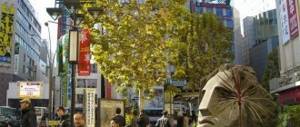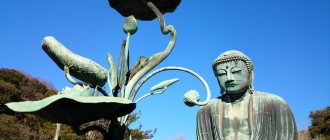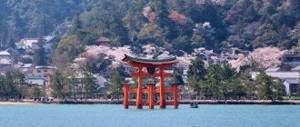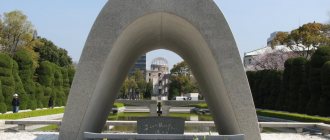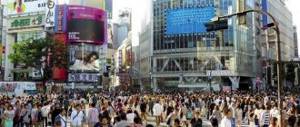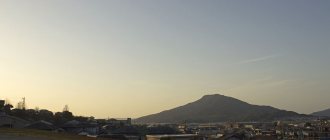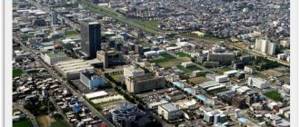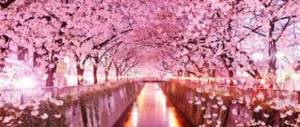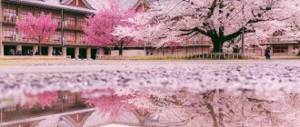Almost every inhabitant of our planet knows about the Japanese city of Hiroshima. Unfortunately, his fame is tragic. In August 1945, Hiroshima was almost completely wiped off the face of the Earth after a nuclear explosion. The only exceptions were some reinforced concrete buildings that were able to survive the power of a nuclear explosion. But, reborn from the ashes of nuclear fire, like the Phoenix bird, developed, industrial Hiroshima became even more beautiful and even stronger. Today it is a city of hundreds of attractions that travelers from different countries seek to visit. Hiroshima has become an undeniable symbol of Peace, an eternal monument to the victims of the first atomic bomb explosion in the history of mankind in a city inhabited by civilians. We invite the reader to take an excursion to this amazing corner of the planet and get acquainted with its sights with us.
The main exhibit of the city
As you know, the nuclear bomb dropped on Hiroshima exploded at a height of more than half a kilometer above the central area of the city. 160 meters horizontally from the epicenter of the explosion, that is, in the immediate vicinity, was the building of the Exhibition Center, where exhibition events of industrialists and trade organizations were organized before the start of World War II. Afterwards, already during the war years, the spacious halls of the Center were occupied by the offices of the administration of the prefecture and the city of Hiroshima.
The building of the Exhibition Center was designed by the Czech architect Jan Letzel back in 1915. The Chamber of Industry was built of brick and reinforced concrete, and stood in stark contrast to the traditional buildings of the city of Hiroshima at the time. The building introduced a touch of Western flavor to the architectural compositions of the city. Thanks to the technological innovations used in its construction, the Exhibition Center building has survived many of Letzel's projects. But the shock wave from the bomb exploding in the sky over Hiroshima hit the roof dome, almost completely destroying it and the walls. A fire of terrifying power in an instant burned out everything that was inside at that moment.
Fortified and partially restored or "Genbaku dome". In 1996, UNESCO, ignoring opposition from China and the United States of America, awarded the building World Heritage status.
In Japan, there is a tradition: in memory of the victims of the atomic explosion, Suitoru’s boats are launched on the waters of the Ota River near the “atomic dome”. Wishes of peace are written on them. The Japanese are still very sensitive to the history of the tragedy.
Hiroshima Memorial Museum
For those who want to experience as vividly as possible the horror of what happened on an August day in 1945 in the city of Hiroshima, it is worth visiting the unique Hiroshima Memorial Museum. It was designed by the famous Japanese architect Kenzo Tange. The list of his works includes the famous Olympic Center and the Catholic Cathedral of the Blessed Virgin Mary (Tokyo). Hiroshima received almost all modern houses from this master. Because it was Tange who led the restoration of the city of Hirsim after the war.
What makes a museum unique? Firstly, the theme itself, and secondly, the concept of construction (the predominance of the will of humanity to revive from ruins), which the architect expressed through the elevation of the base of the Museum buildings above ground level.
The Memorial Museum consists of two buildings:
- The main building, with a smaller area, contains exhibitions depicting the events of the atomic explosion itself. The installations reveal the horror of radiation exposure, fires and destruction. Audio and video recordings of victims and eyewitnesses of that tragedy are also presented here.
- The much larger eastern building contains not only exhibition halls with exhibitions on the history of World War II, Japan's participation in it, the development of nuclear energy, but also lecture halls, a documentary cinema and a library where everyone can study materials related to the events. occurred in the city of Hiroshima before and after the explosion.
The exhibitions of this museum are a visual aid to future generations about what just one atomic bomb can do, although it is far from the most effective and not the most powerful.
How it all began
The history of the project began with a letter, as it is commonly believed that the author of the letter was Albert Einstein. In fact, four people participated in writing this appeal. Leo Szilard, Eugene Wigner, Edward Teller and Albert Einstein.
In 1939, Leo Szilard learned that scientists in Nazi Germany had achieved stunning results on the chain reaction in uranium. Szilard realized how powerful their army would become if these studies were put into practice. Szilard also realized the minimality of his authority in political circles, so he decided to involve Albert Einstein in the problem. Einstein shared Szilard's concerns and composed an appeal to the American president. The appeal was written in German; Szilard, together with the other physicists, translated the letter and added his comments. Now they are faced with the issue of transmitting this letter to the President of America. At first they wanted to convey the letter through the aviator Charles Lindenberg, but he officially issued a statement of sympathy for the German government. Szilard was faced with the problem of finding like-minded people who had contacts with the President of America, and this is how Alexander Sachs was found. It was this person who handed over the letter, albeit two months late. However, the president’s reaction was lightning fast; a council was convened as soon as possible and the Uranium Committee was organized. It was this body that began the first studies of the problem.
Atomic bomb baby photo
Here is an excerpt from this letter:
Recent work by Enrico Fermi and Leo Szilard, whose manuscript version caught my attention, leads me to believe that elemental uranium may become a new and important source of energy in the near future [...] has opened up the possibility of realizing a nuclear chain reaction in a large mass of uranium, which will generate a lot of energy […] thanks to which you can create bombs ..
October 19, 1939
Carp Castle
Next to the modern, large, shiny neon buildings, there is a historical monument of the city of Hiroshima - Rijo Castle.
Behind the authentic contours of the tower's five floors lies more than 400 years of history. Hiroshima did not yet exist at the time of the founding of the “Carp Castle”. Built by a major feudal lord of medieval Japan, Mori Terumoto (successor of the warlord Mori Takamoto), the castle on an island in the Ota River delta has survived many rulers. During the First World War, the headquarters of the Japanese Armed Forces was located within its walls. But the ancient building no longer survived the Second World War.
The wooden structure, destroyed to its stone foundation, was completely restored after the end of the war. Its walls are built of brick and reinforced concrete, and the outside is decorated with wood. Thus, the castle tower in Hiroshima today looks exactly as it did two hundred years ago. It houses a historical museum where visitors can see real samurai armor, original documents from the times of samurai in scrolls, clothes of the nobility and ordinary people, and feel the atmosphere of everyday life in Japan in the 16th – 18th centuries.
From the territory of the Castle, as well as from its windows, you can see beautiful mountain landscapes and no less amazing views of the city of Hiroshima, where there is a place of both modernity and antiquity.
Fountain of Prayer
There is another amazing history of the city of Hiroshima, the sights of which will not leave anyone indifferent. It is connected with the Bank of Hiroshima, whose main building in 1945 was located near the epicenter of the atomic bomb explosion. On the eve of the tragedy, the Teikoku Bank cash vault was equipped with a new reinforced concrete door. The explosion that turned the city of Hiroshima into radioactive dust could only slightly char this structure. All contents of the storage facility were completely intact. Later, the company that made this door uses the tragedy of the Japanese people to promote its products.
The Bank's management, together with a large commercial organization in Hiroshima, decided in 1964 to honor the memory of those killed in the atomic bombing and open a large fountain complex in their honor. The Fountain of Prayer symbolizes the memory of the people who died a terrible death as a result of the bombing of Hiroshima, their torment from unquenchable thirst and the heat of atomic fire.
At night, the fountain, decorated with multi-colored lights, throws out more than 11 tons of water to a height of about 10 meters in one minute. It is part of the Peace Memorial and is located opposite the Hiroshima Museum. It is impossible to pass by this beautiful work without admiration.
Bombing of Nagasaki
On August 6, another target was assigned, with Nagasaki as a backup option.
But due to high clouds above the target, it was decided to drop an atomic bomb on Nagasaki.
The bombing itself was fraught with a number of technical problems, which still could not prevent the attack.
The explosion occurred at 11.02 on August 6, five hundred meters above the city. Since there was no precise sight, the severity of the consequences was far from maximum, but still the damage was quite severe.
In total, about 150 thousand people were affected.
Temples of Hiroshima
Hiroshima is a place of many religions. The port city received foreigners for hundreds of years, who brought with them new customs, religious views, and lifestyle features. But elements of native Japanese architecture have remained for centuries one of the most recognizable symbols of the Land of the Rising Sun.
- A striking example is the arch in Hiroshima - the only element of the Gokoku shrine of the Shinto religious movement that survived the explosion of the atomic bomb. Ritual gates (or torii) were installed in front of the entrance to the sanctuary. Painted bright red, they consist of two vertical supports without doors and two horizontal crossbars: the upper “kasagi” and the lower “nuki”.
In 1868, when the Boshin War ended, followers of Shinto founded the Gokoku Shrine at Rijo Castle in memory of the victims of the bloody war. The atomic explosion destroyed both the Castle and the religious building. In 1965, residents of Hiroshima raised funds from caring people. This money was used to partially restore the Shinto place of worship. The surviving torii (arch in Hiroshima) was also restored, which means that the material from which it was originally made could survive the power of an atomic explosion. Thorium was made from camphor wood.
- The temple of the followers of Buddha Mitaka-dera was founded back in 809. It is dedicated to the goddess of mercy Kannon, borrowed from Chinese Buddhist teachings. The lacquered Tahoto Pagoda was built in her honor. This place is famous for its beautiful gardens of cherry and maple trees, as well as three waterfalls, the water from which is used as an offering during the ceremony to honor the memory of those killed in the cities of Hiroshima and Nagasaki as a result of the atomic bomb explosions.
- The list of Japanese treasures was replenished with many objects, including the Shingon Buddhist temple in the city of Hiroshima. After the explosion in 1945, the Fudoin Temple, the cult of the Medicine Buddha, miraculously survived. The shock wave tore off the roof from its main hall (“condo”). After the war it was restored. This 17th-century building preserves the unique architecture of that period. Besides the condo, Fudoin Temple is famous for its bell tower, gate, and wooden statue of the seated Medicine Buddha. Buddhists believe that touching the statue can cure any illness.
- The Catholic Memorial Cathedral was built on the site of a church that was completely destroyed by an atomic explosion. However, that day, under the ruins of the Christian temple, its abbot Hugo Lassalle survived. In memory of the victims, the priest collected donations and was able to build a majestic cathedral, in which they pray daily for peace throughout the entire Earth. The temple is included in the list of Japanese treasures.
Story
Itsukushima Shrine's kamon is "turtle shell pattern."
Antiquity
In the Late Paleolithic and Jomon period (10,000 BC - 300 BC), the central part of the modern city of Hiroshima was located in the Inland Sea of Japan, the waters of which entered deep into the Ota River delta region. In Hiroshima Bay, in the areas of Itsukaichi, Ushita and Yano, there were islands that were inhabited by people, as evidenced by the sites of ancient people discovered by archaeologists.
During the Yayoi period (300 BC - 300), the northern part of Hiroshima, the modern Asakita area, was inhabited. At the sites of Nakayama, Kami-Fukagawa, Omoji and Fukuda, bronze swords, bells and halberds are found - evidence that the lands of the modern city were the contact zone of the sword and halberd culture of Northern Kyushu and the bell culture of the Kinki region.
During the Kofun period (300–550), the north and center of modern Hiroshima, the Asakita and Asaminami areas, became the site of the construction of burial mounds for the nobility. The most famous are the Nakaoda mounds in the Kutita region, and the Unagiyama and Jinguyama mounds in the Midoriya region.
Beginning in the 7th century, the territory of Hiroshima became part of the province of Aki, a new administrative unit of the young Japanese state of Yamato. During the Nara period (710–794), the government of this province was located in the mountain town of Saijo near the modern city of Higashihiroshima, but in the middle of the Heian period (794–1185) it moved to the village of Fuchu near Hiroshima Bay.
Since the end of the 8th century, due to the death of the existing state system, which was based on the authority of the Emperor and the primacy of state property, the process of development of private land ownership began in the country. During the 9th to 11th centuries, aristocratic estates, Buddhist monasteries, and Shinto shrines arose in what is now Hiroshima. The largest of them were located in the areas of Usita, Kabe, Miiri, Papa, and Gion. A major landowner was Itsukushima Shrine, one of the oldest shrines in Japan.
Middle Ages
Kamon (symbol) of the Takeda clan.
Takeda clan
At the end of the 12th century, dual power was established in Japan: in Western Japan there was the old Imperial government of aristocrats, centered in Kyoto, and in Eastern Japan, there was a new samurai shogunate, centered in Kamakura. The local nobility of Aki Province, which included what is now Hiroshima, supported the Emperor and took his side in the anti-shogunal uprising of 1221. As a result of the defeat of the rebels, Kamakura officials redistributed Aki's lands and entrusted its management to the eastern Japanese Takeda clan.
The Takeda occupied vast lands along the Ota River bed and built their residence at Kanayama Castle, in what is now the Asaminami district. A settlement arose at the base of the castle, where the provincial government located in Futu gradually moved. Takeda's domain became the center of all Aki.
In 1333, the Kamakura shogunate ceased to exist, and in its place another appeared - the Muromachi shogunate, with its center in Kyoto. The Takeda clan recognized the supremacy of the new shoguns and fought for their interests in the war of the northern and southern dynasties, but in 1368 they were deprived of the Aki province. His position was transferred to the Imagawa and Hosokawa clans, close to the house of the shoguns.
From the second half of the 15th century, due to the decline of central power, Japan entered a period of internecine wars. The lands of the Aki province became the object of encroachment by large neighboring landowners - the Ouchi clan from the western province of Suo and the Amago clan from the northern province of Izumo. The small nobility of the province could not do anything to oppose the enemies on their own, and therefore alternately took the side of one or the other neighbor, depending on the situation at the front. The former provincial rulers of Aki from the Takeda clan were in constant alliance with the northern Amaga.
Meanwhile, over the course of the 11th to 15th centuries, the Ota River delta gradually formed in Hiroshima Bay, on the site of the modern urban center. At the river mouth, natural dams and islands formed from sand and soil, which for centuries was carried into the Inland Sea of Japan by the waters of Ota.
Rod Mori
Kamon of the Mori clan
In the mid-16th century, Aki Province evolved from a minor Japanese province to the main center of the Chugoku region. This business was started by Mori Motonari, a representative of the local minor nobility and the head of the Mori samurai family. He successfully exploited the contradictions between the rulers of neighboring provinces, as well as their wards in Aki.
In 1541, with the support of its northern neighbors, Motonari destroyed the ancient Takeda clan and gained authority among the local samurai, but the very next year he accepted the patronage of Western rulers and fought with the northern ones, expanding his lands. In 1554, Motonari turned his arms against yesterday's protectors - the Ouchi clan, and at the Battle of Itsukushima in 1555 he completely defeated its main forces. Within three years, he appropriated the territories of his western neighbors, becoming one of the largest landowners in Western Japan. At the end of the 1550s, the territory of the modern city of Hiroshima was under the control of this commander.
In 1565, while Motonari was still alive, his grandson Mori Terumoto became the new head of the family. Thanks to his grandfather’s instructions, in a year he was able to destroy the northern enemy - the Amago clan. At the beginning of the 1570s, Terumoto controlled the entire Chugoku region, northeastern Kyushu and northwestern Shikoku. 12 of Japan's 60 provinces were subordinate to him.
In 1574, a protracted war began between the Mori and the eastern Oda clan, which united the capital region of Kinki under its hand. It proceeded with varying degrees of success - the diplomatic victories of the former were compensated by the military victories of the latter. Finally, in 1582, the head of the Oda clan, Oda Nobunaga, died, and his successor, Toyotomi Hideyoshi, concluded peace and an alliance with Mori. Although he was signed on equal terms, Mori Terumoto gradually turned into a de facto vassal of yesterday's enemy.
Toyotomi Hideyoshi pursued a course towards the unification of Japan and soon became the master of all the lands of the country. For military merits and assistance at sea, Terumoto received from him the right to govern 6 provinces, with an income of 1,250,000 koku. Although Mori lost half of his lands, he nevertheless remained the largest landowner in Western Japan. The political and administrative center of his domain was the old family castle of Yoshida-Koriyama. It was located in a fortified mountainous area, but lay away from important transport routes. At the end of the 16th century, civil strife in Japan ended, so Terumoto decided to build a new residence in a more economically favorable area.
In 1589, on his orders, the construction of a new family castle began in the Ota River delta, in the Gokamura region. Nearby, Terumoto founded a castle settlement of the same name, into which Mori's vassals, as well as invited artisans and merchants, were resettled. He named this area "Hiroshima" ("broad island"). Terumoto sought to turn it into a populous trade and economic center, like Kyoto and Osaka. In 1591, he moved to the unfinished Hiroshima Castle to personally accelerate the development of his new "capital".
Edo period
Genus Fukushima
Kamon of the Fukushima family is an arrow leaf.
Mori Terumoto was not the master of Hiroshima for long. After the death of Japanese ruler Toyotomi Hideyoshi in 1598, he served on the regency council under the son of the deceased and was embroiled in a conflict over the redistribution of power. In 1600, at the Battle of Sekigahara, Mori led a coalition of Western Japanese rulers against a coalition of Eastern Japanese rulers under Tokugawa Ieyasu, but was defeated. The victors deprived Terumoto of most of his lands, leaving only two provinces - Suo and Nagato.
The central possessions of Mori - the provinces of Aki and Bingo with a center in Hiroshima, with an income of 489,000 koku, went to the hero of the Sekigara Battle - Fukushima Masanori. After 1603, they formed the so-called Hiroshima Khan, an autonomous administrative unit dependent on the newly created Tokugawa shogunate.
Fukushima Masanori continued the work of his predecessor in improving the castle settlement of Hiroshima. Planning to accelerate the development of trade, he brought there the ancient Sanyodo route, which ran through the center of Aki and connected the Japanese capital with the western regions, repaired the roads that led north to the provinces of Izumo and Iwami, where iron and silver mines were located, and also streamlined the tax system .
However, Fukushima did not stay in Hiroshima. In 1619, the shogunate deprived him of his possessions and samurai status. The reason for such a severe punishment was the work to strengthen Hiroshima Castle, which Fukushima carried out without permission from the central government.
Rod Asano
Kamon of the Asano clan - “crossed hawk feathers in a circle.”
The new ruler of Hiroshima was Asano Nagaakira (1619-1632), the former ruler of the Kishu domain from the main line of the Asano clan. He received Aki Province and 8 counties of Bingo Province with an income of 426,000 koku. Nagaakira centralized government, weakening the local nobility, and reduced taxes on merchant houses, encouraging economic development. He managed to monopolize commercial operations in the Inland Sea of Japan, for which his descendants called him “the master of trade.” Nagaakira delegated power in the castle settlement of Hiroshima to the institute of local officials reporting to him, and he himself supervised all the lands from the ancestral castle-residence.
The second head of the Principality of Hiroshima, Asano Mitsuakira (1632–1672), continued the course of his father. He established a permanent tax on peasants, giving peasants the opportunity to sell surplus products and crops on the market. Mitsuakira also repaired the Sanyodo Trail that ran through Hiroshima and promoted the development of river and sea transport in his domain.
Mitsuakira's son, Asano Tsunaakira (1672–1673), reigned for only a year, dying of smallpox. His successor, Asano Tsunanaga (1673–1708), was a patron of the arts and sciences and undermined the stability of the financial system of the Hiroshima domain. To improve the situation, he decided to save money and established workshops in the castle village of Hiroshima, monopolizing the production of iron and paper. Tsunaakira tried to introduce paper money due to a shortage of gold and silver, but his innovations caused strong protest in the province.
The fifth ruler of the domain, Asano Yoshinaga (1708–1752) was an energetic reformer. He rejuvenated his bureaucracy, began to issue princely banknotes instead of payment in kind, increased taxes and strengthened control in counties and villages. All these measures led to discontent among the samurai administration and ordinary people, which resulted in a great uprising in 1718. As a result, Yoshinaga's reforms slowed down, and the economy of the Asano clan's lands fell into decline.
During the tenure of the sixth ruler, Asano Munetsune (1752-1763), the first signs of a way out of the crisis appeared. Taking into account the lean years and the great fire in Hiroshima, the new ruler eliminated the system of hereditary salaries, brought new capable administrators to the leadership, actively fought corruption in the regions, and also halved taxes, making the tax collection system effective. These transformations were continued by the seventh prince Asano Shigeakira (1763-1799). Under pain of death, he banned bribery and luxury, introduced laws in support of local goods producers and, having restored the settlement damaged by the fire and equipped a port, launched extensive maritime trade with his neighbors. Concerned about future management personnel, Shigeakira founded a number of schools in Hiroshima, where Chinese, Japanese and Western sciences, as well as medicine and mathematics were taught.
During the presidency of Asano Narikata (1799–1830), the Hiroshima domain became one of the wealthiest in Japan. The settlement expanded to the south as a result of the reclamation of the coastal strip, and in 1820 there were several dozen blocks. The number of its inhabitants exceeded 70 thousand, which raised Hiroshima to fifth place among Japanese cities, after Edo, Osaka, Kyoto and Kanazawa. Hiroshima was also a major commercial center, where merchant boats arrived from distant provinces in the south and north of Japan. The town exported paper, bamboo products, hemp fabrics, seaweed and oysters.
However, the prosperity was short-lived. During the reign of the ninth head, Asano Naritaka (1831–1858), Hiroshima Khan suffered greatly from the all-Japanese great famine of 1833–1839, which undermined the economy of the principality and caused mass unrest in villages and cities. Residents of Hiroshima robbed the food warehouses of wealthy merchants and rice speculators. Neither Naritaka himself, nor his successor Asano Yoshiteru (1858), who died 4 months after taking power, were able to resolve the socio-economic crisis. However, the situation improved with the coming to power of the eleventh prince from the Asano clan, Asano Nagamichi. He was able to reform the management system, army and finance. The economy was also helped by the war between neighboring Choshu and the All Japan Government in 1863–1865, during which the country's top dignitaries were stationed in Hiroshima.
By the middle of the 19th century, Japan was experiencing a deep political and socio-economic crisis, and was also in danger of colonization by the leading Western states and Russia. The Japanese government found itself powerless in the face of the challenge, and strong regional opposition formed against it, seeking the restoration of direct imperial rule and the creation of a unitary, centralized state. In 1867, the Principality of Hiroshima entered into an alliance with the leading forces of this opposition, the principalities of Choshu and Satsuma, and, after the abdication of the last shogun and the liquidation of the shogunate, took part in the formation of a new monarchical government. A new era of modernization and Westernization of Japan has begun.
Hiroshima during the Meiji period
Emblem of the Imperial Japanese Army
In July 1871, Hiroshima Khan was renamed Hiroshima Prefecture.
The following November, the castle town of Hiroshima was renamed Hiroshima District.
In 1888, a new administrative division came into force in the country, and on April 1, 1889, the Hiroshima region was one of the first in Japan to be transformed into the city of Hiroshima.
The area of Hiroshima at that time was about 27 km².
Settlements near Hiroshima were reorganized into small towns and villages.
During 1884–1889, the coastal sea areas in the south of Hiroshima were drained and the modern port of Ujina was built.
In June 1894, the Sanyo Railway was built into the city, connecting the city with Tokyo. With the outbreak of the Sino-Japanese War in August 1894, a military railway was built at an accelerated pace, connecting Hiroshima Station with the city port.
All city roads and sea routes were also streamlined. In September 1894, Hiroshima Castle became the location of the General Headquarters of the Japanese Armed Forces. In October, Parliament temporarily met in Hiroshima.
In 1903, Hiroshima was connected by rail to the city of Kure, a port and base of the Imperial Japanese Navy, and with the outbreak of the Russo-Japanese War in 1904, Hiroshima was transformed into a stronghold of the Imperial Japanese Army.
Gradually, Hiroshima became one of the main political-administrative, military-transport and socio-economic centers of the Japanese Empire.
Bombing of Hiroshima
On August 6, 1945, at 08:15 local time, in accordance with the ultimatum of the Potsdam Declaration of July 26, 1945 and Japan's refusal to comply with the terms of the ultimatum, the American B-29 Enola Gay bomber, piloted by Paul Tibbets and bombardier Tom Ferebee, dropped the first an atomic bomb called "Little Boy".
It exploded approximately 600 meters above the surface with the explosive equivalent of approximately 20 kilotons of TNT. The epicenter of the explosion was at the Sima hospital. Hiroshima was chosen as the target of the atomic attack because in 1945, Hiroshima was the location of Japan's second General Headquarters and the General Headquarters of the Navy.
A significant part of the city was destroyed, 70 thousand people were killed in the explosion, another 60 thousand died from radiation sickness, burns and wounds.
Approximately 2,000 of this number (another 800–1,000 died from the effects of the explosion) were Japanese Americans who studied here before the war and were interned in Japan. Most likely, hundreds of American prisoners of war also died.
The most famous exhibit related to the atomic explosion is the Genbaku Dome (left) and modern buildings
The radius of the zone of complete destruction was approximately 1.6 kilometers, and fires occurred over an area of 11.4 square kilometers. 90% of Hiroshima's buildings were either damaged or completely destroyed. The city's tram system survived the bombing.
In the first six months after the bombing, 140 thousand people died.
Hiroshima after the war
On August 6, 1949, the Japanese government proclaimed Hiroshima a “city of peace” and decided to develop the city.
Part of the funds from the state budget was transferred to restore the city. In the area of the epicenter of the explosion, the Peace Memorial Park was created, with an area of more than 12 hectares. At the beginning of the 1960s, Hiroshima was almost completely restored.
The territory of the city increased due to the annexation of neighboring settlements.
Art objects
In addition to historical buildings and museum exhibits, the history of Hiroshima is presented in art museums.
One of them (the Hiroshima Museum of Art, it’s definitely on the guidebook map) was opened with sponsorship from the Bank of Hiroshima in honor of the anniversary of the 1945 tragedy. In the central park of the city, not far from the walls of Rijo Castle, there is a small one-story rotunda. It is connected through underground passages with four more exhibition pavilions. Here you can see paintings by Japanese artists who, in the period after the country’s self-isolation, painted under the influence of European artistic movements during the 19th – 20th centuries, as well as masters of European schools, inspired by the authentic and unique Japanese artistic style.
The collections of the Hiroshima Museum are represented by romantic works by Eugene de Lacroix, impressionist portraits of Manet, Degas, and Renoir. One of the most famous pearls of the collections of the Hiroshima Museum of Art is Van Gogh’s painting “Daubigny’s Garden,” which he painted shortly before his death, as well as paintings by Paul Gauguin, Henri de Toulouse-Latrain, Picasso, Chagall and other equally famous artists.
Amazing artistic works of Japanese masters were born in the union of European influences and traditional Japanese art. Thus, the most relevant in modern art of the 20th century is the “yoga” school. Its most prominent representative was Tsuguharu Fujita, who worked in France. No less popular are the works of Chu Asai, Seiko Kuroda, Takeji Fujishima, and Saburosuke Okada. Many of them gradually returned to the traditional paintings of their native Nihonga style in their works.
Flora and fauna of Hiroshima
- The city of Hiroshima is located in a warm and humid climate zone. The weather in Hiroshima is mild and the temperature rarely drops below zero even in winter, so the flora and fauna of this region is quite diverse. Travelers who want to see the unique creatures of wildlife on the Japanese islands simply must visit one of the best botanical gardens that Japan is rich in. Hiroshima is famous for its Botanical Garden, which contains representatives of the plant world from all over the world.
On 18 hectares of land off the coast of the Inland Sea of Japan, on a hill on the island of Honshu, the unique Hiroshima Botanical Garden is located. In the Garden, open to visitors since 1976, today there are more than 11 thousand different plant species with a total of over 200 thousand specimens. Here, in numerous pavilions and open areas, endemic plants from various parts of the world and classic Japanese garden plants are grown. Beautiful orchids, fuchsias, camellias, water lilies and begonias, and even cacti - all this can be seen at the Hiroshima Botanical Garden. In addition to representatives of the plant kingdom, the Garden is home to more than 50 species of birds from different countries of the world.
- Zoological Park Asa. More than 1,600 representatives of the fauna of our planet live freely on almost 50 hectares of land in the suburbs of Hiroshima (that’s 170 different species). Among them you can find animals from the small mandarin duck to the Himalayan bears and gigantic salamanders, meet giant turtles, small meerkats, rare Amur tigers and red pandas. Representatives of the animal world in Asa Park are divided into three parts: animals of the African continent, animals of Asia and representatives of the animal world of the Japanese islands.
- Shukkeien Garden is one of the most visited places by tourists in the city of Hiroshima. The history of its creation goes back to 1620. Uedo Soko, master of tea ceremonies and vassal of the new ruler of Bingo Province, Asano Nagaakira, began construction of a garden that would brighten up the grounds of Rijo Castle. According to the plan, the garden was supposed to personify the legendary Hangzhou Lake. It was called Shukkeien, that is, “garden of miniature landscapes.” The unique topography of the area alternates between valleys and plains, captivating with dense plantings of trees and flowers representing all seasons, and cozy gazebos and tea houses are located along the winding stone paths and bridges near Lake Takuey.
Emperor Hirohito of Japan
Japanese Emperor Hirohito had good leadership abilities. In order to expand his lands, in 1935 he decided to capture all of China, which at that time was a backward agrarian country. Following the example of Hitler (with whom Japan entered into a military alliance in 1941), Hirohito begins to conquer China using methods favored by the Nazis.
In order to cleanse China of its indigenous inhabitants, Japanese troops used chemical weapons, which were banned. Inhumane experiments were carried out on the Chinese, with the goal of finding out the limits of the viability of the human body in various situations. In total, about 25 million Chinese died during Japanese expansion, most of whom were children and women.
It is possible that the nuclear bombing of Japanese cities might not have taken place if, after concluding a military pact with Hitler's Germany, the Emperor of Japan had not given the order to launch an attack on Pearl Harbor, thereby provoking the United States to enter World War II. After this event, the date of the nuclear attack begins to approach with inexorable speed.
When it became clear that Germany's defeat was inevitable, the question of Japan's surrender seemed to be a matter of time. However, the Japanese emperor, the embodiment of samurai arrogance and a true God for his subjects, ordered all residents of the country to fight to the last drop of blood. Everyone, without exception, had to resist the invader, from soldiers to women and children. Knowing the mentality of the Japanese, there was no doubt that the residents would carry out the will of their emperor.
In order to force Japan to capitulate, radical measures had to be taken. The atomic explosion, which occurred first in Hiroshima and then in Nagasaki, turned out to be precisely the impetus that convinced the emperor of the futility of resistance.
Echoes of Hiroshima
Hiroshima is not just a city in Japan. Hiroshima is already a certain historically established stereotype of a victim, proud and undefeated. The fortitude of people who survived the atomic bombing of Hiroshima and Nagasaki, whose life and death stories bring tears to tears, is described in many television projects. A lot of documentaries and feature films have been shot, including “The Stones of Hiroshima” by Kozaburo Yoshimura, “Children of Hiroshima” by Kaneto Shindo, “Hiroshima, My Love” by Alain Rene.
Film critics in France, Japan and other countries recognize the value of these dramatic films. Thanks to them, it is possible to feel more deeply and not forget the whole tragedy of the events of those years.
In addition to feature films and documentaries that reveal history, Hiroshima also left its mark on musical creativity. All over the world, in various musical genres, you can find songs dedicated to the residents and the city of Hiroshima itself before and after the disaster. Japanese operas, compositions by European and American performers, and even the Russian rock group “Mobile Hiroshimas” - all of them, in one form or another, characteristic of a certain musical genre, convey their feelings and views regarding the tragedy of the Japanese people.
The echo of the Hiroshima tragedy makes people think about what could happen if their worst fears come true and nuclear weapons are used. After all, millions of people can become victims of nuclear fire overnight, and there will be no winners in this war. And who knows whether humanity will survive after the global Hiroshima?
Nuclear threat
Hiroshima and Nagasaki. On the world map, these two cities are barely distinguishable. But their story shows us what can happen to the world. The use of atomic weapons poses a threat to all humanity. According to the Stockholm Peace Research Institute, today more than 20 thousand nuclear weapons are stored in different countries and more than 5 thousand of them are ready for use at any time. The United States and Russia each have more than 2 thousand nuclear warheads deployed and ready to fly to the borders of an enemy state. China, Pakistan, India and Israel so far store their weapons only in arsenals.
There is a treaty on the non-proliferation of atomic weapons and gradually their reserves are becoming smaller. Unfortunately, countries such as the DPRK and Iran are actively developing in this area, which raises particular concerns. Few people know, but from 1945 to 1998, a huge number of atomic explosions occurred all over the world. Their number is amazing. During those half-century, 2053 nuclear charges were detonated on Earth.
Japanese artist Isao Hashimoto created a visual animated map showing who, when and how many atomic bombs were detonated. Each of these explosions causes enormous harm to the environment, and it is unknown how the testing of atomic weapons will affect future generations. Testing of new types of atomic bombs continues today, but this is done with greater secrecy.
There is a theory according to which the United States of America developed the “little Hiroshima” doctrine, which involves launching high-precision atomic strikes against military targets and government entities as a preventive measure. Containing aggressor countries using the “little Hiroshima” method raises serious concerns among experts. The stockpiles of atomic weapons on Earth are large. According to some estimates, a chain reaction launched and the use of the entire arsenal of nuclear weapons can completely destroy our planet several times, killing all living things. It can be assumed that some representatives of humanity will still be able to survive after atomic explosions, as was the case in the city of Hiroshima. No one knows for sure what might happen to them later. The nuclear winter that will cover the planet after a nuclear war will kill what is not burned in the fires. The survivors will die from cold, lack of food, disease and radiation.
What happened in Hiroshima on the day of the tragedy
The first Japanese official sources said that the city of Hiroshima was attacked by new bombs that were dropped from several American aircraft. People did not yet know that the new bombs destroyed tens of thousands of lives in an instant, and the consequences of a nuclear explosion would last for decades.
It is possible that even the American scientists who created atomic weapons did not imagine what consequences radiation would have for people. For 16 hours after the explosion, not a single signal was received from Hiroshima. Noticing this, the Broadcast Station operator began making attempts to contact the city, but the city remained silent.
After a short period of time, incomprehensible and confusing information came from the railway station, which was located not far from the city, from which the Japanese authorities understood only one thing: an enemy raid had been carried out on the city. It was decided to send the plane for reconnaissance, since the authorities knew for sure that no serious enemy combat air groups had broken through the front line.
Approaching the city at a distance of about 160 kilometers, the pilot and the officer accompanying him saw a huge dust cloud. As they flew closer, they saw a terrible picture of destruction: the entire city was ablaze with fires, and smoke and dust made it difficult to discern the details of the tragedy.
Having landed in a safe place, the Japanese officer reported to the command that the city of Hiroshima had been destroyed by US aircraft. After this, the military began to selflessly provide assistance to their wounded and shell-shocked compatriots from the bomb explosion.
This disaster united all the surviving people into one big family. Wounded people, barely able to stand, cleared the rubble and put out fires, trying to save as many compatriots as possible.
Washington made an official statement about the successful operation only 16 hours after the bombing.
